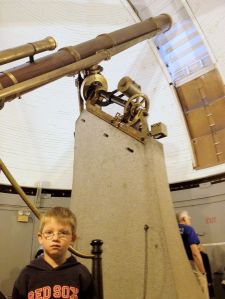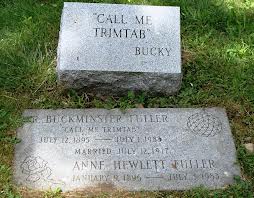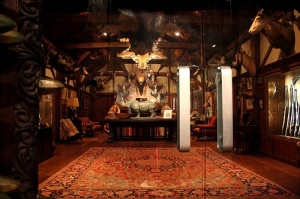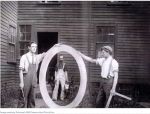Boston has been industrialized for over 200 years, so there’s plenty to see around the city for the technically-minded traveler, or for the local looking for a family outing. Since it’s hard to decide which are my favorites, I’ll just put them in alphabetic order.
Battleship Cove, Fall River, Collection of 20th C warships
Huge evil machines, remnants of the worst war in human history, and now a place for overnight camps by Boy Scouts. The battleship USS Massachusetts fought in WW II in the Mediterranean, South Pacific, and Japan. It carried hundreds of 2700-lb 16″ shells, enough to demolish cities. There are also the WW II submarine USS Lionfish, the Korean-era destroyer USS Joseph P. Kennedy, an East German missile cruiser from the 1970s, two PT boats, and several aircraft. The battleship still smells of oil after forty years of being berthed here.
Charles River Museum of Industry, Waltham, site of first MA textile mill, 1814
Start of the US Industrial Revolution with IP stolen from the UK. Lots of 19th and early 20th C tech. Some references here: Steampunk vs Apple-ism .
There are great restaurants nearby on Moody St, named for the mill’s chief engineer, Paul Moody.
The Great Refractor, Harvard/Smithsonian Astrophysical Center, Cambridge,
The world’s largest refracting telescope in 1847, still operational. Open to the public for star-gazing on rare occasions. The Center hosts meetings of the Amateur Telescope Makers of Boston on the second Thursday of each month, More here: The Persistence of Beautiful Things
Harvard Museum of Comparative Zoology/Minerals/Glass Flowers
What natural history museums used to be like, full of actual specimens of nature, instead of models with primary colors for schoolchildren.
John Woodman Higgins Armor Collection, Worcester Art Museum, Collection of suits of armor and weapons
The personal collection of a local businessman, John Woodman Higgins, who snarfed up all he could he find in Europe in the 20s and 30s, then built a castle to display it all. He once staged a banquet in its main hall, and had his sons hide out in the suits that were arrayed along the walls. They came to life in the middle of the meal, yielding a highly satisfactory reaction from his dinner guests. The castle museum folded, unfortunately, but the collection found a new home in the nearby art museum.
Lowell Mills National Historical Park, Lowell, Early textile mills
The original factory town, entirely built around hydro power from the Merrimack River, with dorm housing for young women from all over the New England. Terrific folk festival in the summer.
Mark I Computer, Harvard University Science Center, Cambridge
Built in 1944, this was one of the first true programmable computers. It had 500 miles of wiring, weighed 5 tons, and could do about 4 72-bit adds per second. It was too early for even vacuum tubes; it used thousands of relays instead, and sounded like “a roomful of knitting needles” when working. Designed by Howard Aiken and programmed by Grace Hopper.
Metropolitan Waterworks Museum, Boston, Major pumping station
Gigantic gleaming steam engines that pumped tens of millions of water a day into the city up until the 1970s, and an exemplar of the nobility of public works engineering. More here: When People Were Proud of Their Government
MIT Museum, Cambridge, Early radar, Arthur Ganson sculpture
There isn’t much to see at MIT proper, although its vast interconnected complex of buildings is a strange and daunting labyrinth all by itself. Its museum has lots of random stuff from the centuries of work at MIT, but my own favorite is the collection of Arthur Ganson‘s mechanical sculptures.

Each gear turns 60X slower than the one before it. The first can be turned by hand, and the last is embedded in concrete
Mount Auburn Cemetery, Cambridge, Graves of the greats
Final resting place for: Buckminster Fuller (geodesic dome), Henry Burkhardt III (Data General, Encore, KSR), William Barton Rogers (founder of MIT), Harold Doc Edgerton (strobe pioneer), Edwin Land (Polaroid), BF Skinner (behaviorist), Louis Agassiz (discover of the Ice Ages), Asa Gray (leading botanist), Katharine Burr Blodgett (anti-reflective coatings), Nathaniel Bowditch (marine navigation)
Museum of Science, Boston, Gears, ships, dioramas
The best stuff here is in the neglected corners of the museum in the basement, like a display case that has every known form of gear, or the ship collections, or the dioramas of New England landscapes. At one point they received an entire trophy room full of murdered animal heads as a bequest, and had to install it down there with a highly apologetic plaque. Gotta do what donors want.
Musical Instrument Collection, Museum of Fine Arts, Boston
Weird and wonderful musical mechanisms from every era and place. No pictures, sadly, because the MFA charges for them all. Their new American wing is also spectacular.
Old Schwamb Mill, Arlington, 19th C wood-working factory
Intricate belt-driven lathes, still working after 150 years. They had fixtures for cutting oval picture frames. Their last main project was turning wood from the Washington Elm (where George mustered the troops on Cambridge Common) into frames for DC gifts. More here:
The Last Factory
Not open often, though, so check for times.
Saugus Iron Works, Saugus, First iron blast furnace in North America, 1648.
The core technology of 17th century industry, yet quite easy for modern eyes to follow. The highest tech of its day, and desperately needed by the young and vulnerable Massachusetts Bay colony, but a failure. More here: A Failed High-Tech Gamble
A pleasant picnic spot!
USS Constitution, Boston, World’s oldest warship still afloat (1797)
Active for almost 60 years, and never defeated, it’s still a registered ship in the US Navy. On the Fourth of July it gets towed out into Boston Harbor and turned around so that the sides wear evenly. We once happened to be on Spectacle Island on the Fourth, and saw the grand ship moving out, surrounded by hundreds of small craft. Two fast corvettes then zoomed into the harbor, both flying the Canadian flag. The Constitution let them have it with a broadside, and Boston was saved from invasion once again.













